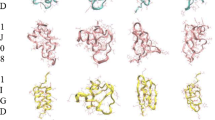Abstract
Misfolding during protein self-assembly is the cause of numerous human and animal diseases. Understanding of the mechanism that underlies the protein folding into a normal or abnormal form can enhance the search for pathogen inhibitors and drug design. We used Monte Carlo dynamics to study the folding of a 27-membered heteropolymer on a cubic lattice. This lattice protein had a stable compact (“latent”) state that competed with the native state. It appeared that the free-energy surface of the system studied consisted of three basins, which corresponded to the semicompact globule, latent, and native states. We determined the bifurcation regions in the protein kinetic trajectories where the protein took a native or a latent structure and the probabilities of these structures to be formed. The effects of mutations on the probability of native state and the rate of its formation were modeled.
Similar content being viewed by others
References
A. V. Finkelstein and O. B. Ptitsyn, Protein Physics (Academic Press, 2002).
N. I. Dobson, Nat. Rev. Drug Discov. 2, 154 (2003).
A. R. Dinner, A. Sali, L. J. Smith, et al., Trends Biochem. Sci. 25(7), 331 (2000).
Y. Duan and P. A. Kollman, Science 282(5389), 740 (1998).
D. J. Wales, Energy Landscapes: With Application to Clusters, Biomolecules and Glasses (Cambridge University Press, 2004).
A. F. Voter, Phys. Rev. B 57(22), 13985 (1998).
M. R. Shirts and V. J. Pande, Phys. Rev. Lett. 86(22), 4983 (2001).
V. I. Abkevich, A. M. Gutin, and E. I. Shakhnovich, Proteins 31(4), 335 (1998).
P. M. Harrison, H. S. Chan, S. B. Prusiner, and F. E. Cohen, J. Mol. Biol. 286(2), 593 (1999).
J. Z. Y. Chen, A. S. Lemak, J. R. Lepock, and J. P. Kemp, Proteins 51(22), 283 (2003).
N. Gō, Annu. Rev. Biophys. Bioeng. 12, 183 (1983).
I. I. Titov and A. Yu. Palyanov, Biofizika 48(Suppl. 1), 133 (2003).
N. Metropolis, A. W. Rosenbluth, M. N. Rosenbluth, et al., J. Chem. Phys. 21(6), 1087 (1953).
O. V. Galzitskaya and A.V. Finkelstein, Protein Eng. 8(2), 883 (1995).
A. Yu. Palyanov and I. I. Titov, Proceedings of the Fourth International Conference on Bioinformatics of Genome Regulation and Structure, Novosibirsk, Russia, 2004, Vol. 1, pp. 330–332.
S. F. Chekmarev, S. V. Krivov, and M. Karplus, J. Phys. Chem. A 109, 5312 (2005).
M. Gruebele, Curr. Opin. Struct. Biol. 12(2), 161 (2002).
Author information
Authors and Affiliations
Rights and permissions
About this article
Cite this article
Pal’yanov, A.Y., Titov, I.I., Chekmarev, S.F. et al. Simulation of protein misfolding using a lattice model. BIOPHYSICS 51 (Suppl 1), 44–48 (2006). https://doi.org/10.1134/S0006350906070098
Published:
Issue Date:
DOI: https://doi.org/10.1134/S0006350906070098




